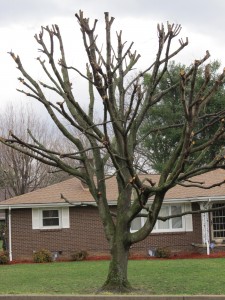Why do people top trees? Often, it is because “their neighbor(s) did it”. When asked whether they believe their neighbor to be a wise person, the typical response is “NO”.
The Negatives About Tree Topping: 1. A topped tree reduces property values in a community. Topping adds a blight look to a neighborhood or over an entire city; 2. A topped tree is more threatening. Re-growth branches are weak and dangerous to park cars, people, and particularly children playing beneath them; 3. A topped tree costs you more in future expenses; and 4. The tree may not survive topping.
If you feel threatened by a large tree, either have the tree pruned by a certified tree arborist or remove the tree. Select a new replacement tree based on its height at maturity. A properly pruned tree has limbs cutback to their point of attachment to a larger branch or trunk.
What’s wrong with tree topping:
- Removal of too much tree top reduces numbers of leaves, starving tree roots
- Opening tree center causes sunscald, injuring bark and burning wood which leads to disease
- Large pruning cuts don’t heal, causing tree infections
- New growths are weak and snap off in wind and ice storms making tree more hazardous
- Disfigures the overall look of the tree


 Posted in
Posted in 

I really enjoy your newsletter and have learned many successful practices through you. Thanks! I wonder how you feel about “pollarding?” One often sees it in Europe, where ancient trees have regularly had their tops cut back. From this inexperienced eye, the trees appear very healthy. I’ve seen this practice in Japan, too, where trees are revered and live hundreds of years. Is it a completely different practice?
Pollardizing is pruning at the same lateral point every year. It is time- consuming practice, and tought to have started in Europe and eastern Asia as a means of harvesting wood fuel from trees annually. Each spring, all previous lateral growths are removed from the original branch cut or now the “swollen head”.
Tree topping practice is indescriminate or random in which the tree is not revisited every year. Over time the re-growths become heavier and thicker. Most are weakly attached to the original branch cut. High winds eventually create a dangerous condition for pedestrians, home and property…Hugh